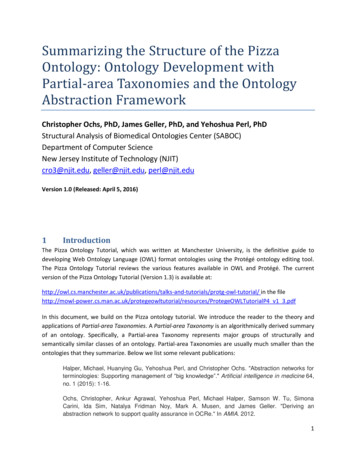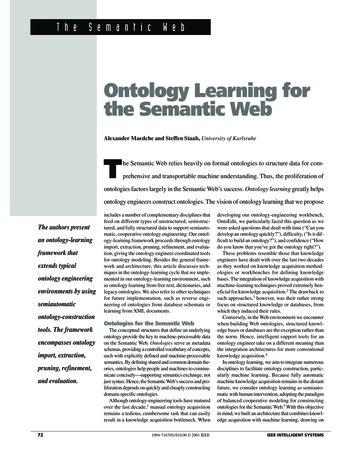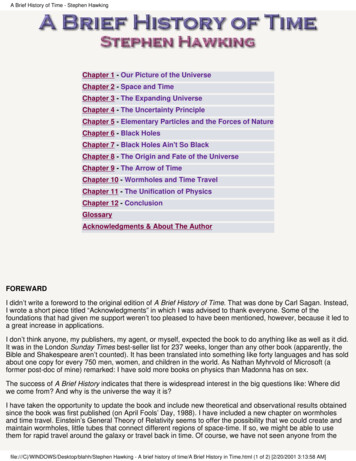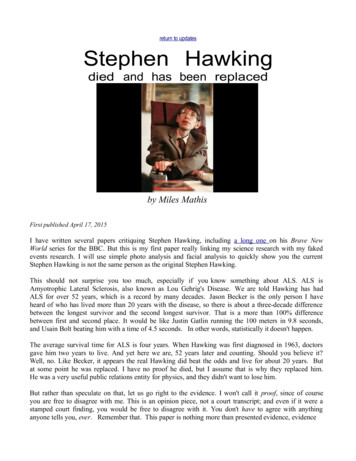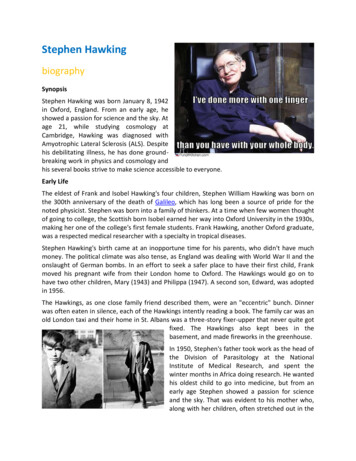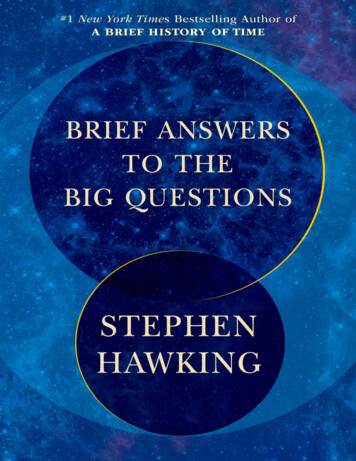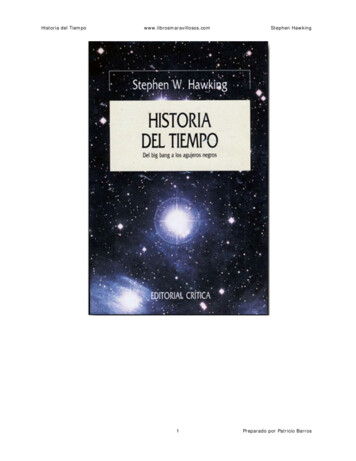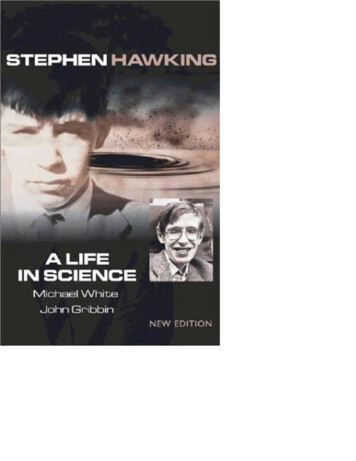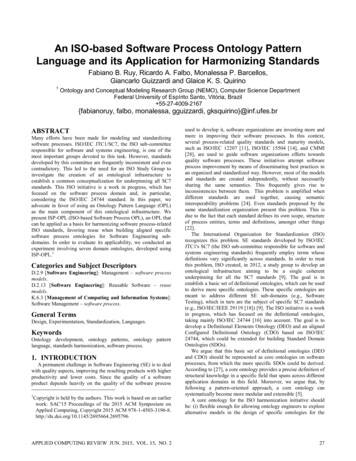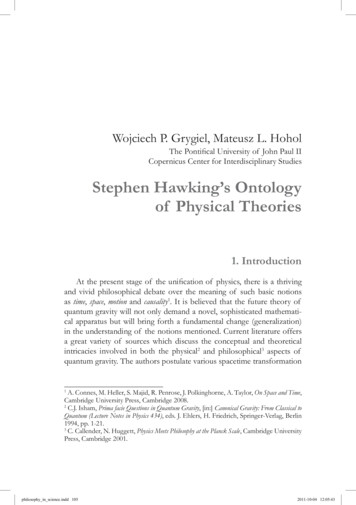
Transcription
S t e p h e n H a w k i n g ’s O n t o l o g y o f P h y s i c a l T h e o r i e s105Wojciech P. Grygiel, Mateusz L. HoholThe Pontifical University of John Paul IICopernicus Center for Interdisciplinary StudiesStephen Hawking’s Ontologyof Physical Theories1. IntroductionAt the present stage of the unification of physics, there is a thrivingand vivid philosophical debate over the meaning of such basic notionsas time, space, motion and causality1. It is believed that the future theory ofquantum gravity will not only demand a novel, sophisticated mathematical apparatus but will bring forth a fundamental change (generalization)in the understanding of the notions mentioned. Current literature offersa great variety of sources which discuss the conceptual and theoreticalintricacies involved in both the physical2 and philosophical3 aspects ofquantum gravity. The authors postulate various spacetime transformationA. Connes, M. Heller, S. Majid, R. Penrose, J. Polkinghorne, A. Taylor, On Space and Time,Cambridge University Press, Cambridge 2008.2C.J. Isham, Prima facie Questions in Quantum Gravity, [in:] Canonical Gravity: From Classical toQuantum (Lecture Notes in Physics 434), eds. J. Ehlers, H. Friedrich, Springer-Verlag, Berlin1994, pp. 1-21.3C. Callender, N. Huggett, Physics Meets Philosophy at the Planck Scale, Cambridge UniversityPress, Cambridge 2001.1philosophy in science.indd 1052011-10-04 12:05:43
106W o j c i e c h P. G r y g i e l , M a t e u s z L . H o h o lschemes as one shifts to the quantum regime: should spacetime retainits continuous character of a smooth manifold with the Lorentzian metric or should it be quantized? Is it an absolute entity or does it emergefrom a more primitive structure? What is the function of symmetries?The history of science offers many examples of famous debates betweenrenowned physicists where the issues at stake have provoked discussion ofa profoundly philosophical nature. The early 20th century debate betweenAlbert Einstein and Niels Bohr on the foundations of quantum mechanics yields serves as a perfect example4. Although this debate is consideredto continue into the controversy between Stephen Hawking and RogerPenrose, the much larger and abstract scope of matters discussed seemsto limit the direct Bohr-Hawking and Einstein-Penrose match.Inasmuch as these issues have their importance, the very relation between the mathematical structure of a theory and the physical reality thatthe theory purports to describe seems to be a more basic philosophicalniveau that is operative in the unification schemes of physical theories.The analysis of this relation occupies a prominent position within thecontemporary philosophy of science for it raises concerns of an ontologicaland epistemological nature. In other words, the basic questions of what really exists in the eyes of a contemporary theorist and what knowledge heis able to acquire come to the fore. The task of characterizing the statusof physical theories in these perspectives, centres on the following issues:(1) the origin of the mathematical structure of a physical theory and theontological status of theoretical objects warranted by the theory (philosophyof mathematics), (2) the relation between mathematical structures and thephysical reality, namely, whether mathematical structures reflect the structure of physical reality (scientific realism) or whether they are only usefulmodels in the process of organizing and predicting experimental results.While most practicing physicists admit the existence of an externalphysical reality as an object of their study, the different positions splitquite rapidly as one considers the two issues mentioned above. For example, Roger Penrose assumes the stance of a radical realist on both counts.In his global ontology of the three worlds – math, matter and mind – hemakes a strong ontological assumption by postulating the existence of4M. Jammer, The Philosophy of Quantum Mechanics: The Interpretations of QM in historicalperspective, John Wiley and Sons, New York 1974.philosophy in science.indd 1062011-10-04 12:05:43
S t e p h e n H a w k i n g ’s O n t o l o g y o f P h y s i c a l T h e o r i e s107an atemporal universum of mathematical ideas (mathematical Platonism)5.Its subset yields the basis for the laws governing the physical universe.In other words, objectively existing mathematical structures underpin thephysical reality similarly to how software runs hardware. As for his stancein this regard, Albert Einstein made a more modest ontological claim, forhe did not assign any independent mode of existence to the mathematical ideas, but treated them as the product of the human mind. However,he did impose a considerable philosophical demand by stating that natureemploys only the simplest mathematical structures6.Thanks to the newly published book by Stephen Hawking and Leonard Mlodinow, entitled The Grand Design, the so far scattered and oftenpoorly justified philosophical assertions of Hawking can be neatly gathered under the term of model-dependent realism7. The immediate advantageof such a standpoint is that it neutralizes the classical ontological division between realism and antirealism. Consequently, “it is pointless to askwhether a model is real, only whether it agrees with observation”8.The goal of this study is to demonstrate how the model-dependent realism influences the course of a theory’s formulation as well as its particularmode of explanation and prediction of physical phenomena. Since at present the theory of quantum gravity is nowhere near being fully formulatedand there are no experimental results to indicate a preferred route of discovery, an ample space for philosophical speculation and preference opens up.The far reaching consequences of Hawking’s theoretical proposals make theanalysis of the impact of philosophical ideas on these proposals particularlyintriguing. The structure of the presented article is twofold: (1) the detailedsurvey of the meaning and the philosophical import of the model-dependent realism and (2) an analysis of Hawking’s major contributions, such asthe Euclidean quantum gravity programme crowned by the famous HartleHawking model, with special emphasis on how the assumed ontology ofphysical theories is refracted in his practice of physics.R. Penrose, The Road to Reality, Alfred Knopf, New York 2005, pp. 7-23.A. Einstein, On the Method of Theoretical Physics, “Philosophy of Science” 1934, vol. 1, no. 2,pp. 163-169.7S.W. Hawking, L. Mlodinow, The Grand Design, Bentam Press, London 2010, p. 37 et seq.8Ibidem, p. 46.56philosophy in science.indd 1072011-10-04 12:05:43
108W o j c i e c h P. G r y g i e l , M a t e u s z L . H o h o l2. The Origin of a Physical Theoryand the Status of Theoretical EntitiesThe strength with which Stephen Hawking makes his numerous positivistdeclarations in his popular writings such as A Brief History of Time, could easilylead to the suspicion that he blindly assumes the reducibility of the content ofmathematical structures to the empirical data, as it had been the case for logical empiricism. Such an inference may additionally be fortified, as he frequentlyformulates the common requirement that a physical theory must be empirically verifiable and permit prediction of the results of measurements. It iscommonly assumed in the contemporary philosophy of science that anyonewho is solely concerned with discovering regularities in the behaviour of observable entities should be termed a positivist9. After all, this seems like the‘working philosophy’ of many contemporary physicists. Taken to its extreme,such a strategy could imply that mathematical structures arise inductively as astraightforward generalization of the empirical data. According to Hawking:a theory is just a model of the universe, or a restricted part of it, anda set of rules that relate quantities in the model to observations thatwe make. It exists only in our minds and does not have any otherreality (whatever that might mean). A theory is a good theory if itsatisfies two requirements. It must accurately describe a large classof observations on the basis of a model that contains only a fewarbitrary elements, and it must make definite predictions about theresults of future observations10.Also, Hawking insists that the number of theoretical entities introducedshould be confined to a minimum, according to the precept of Occam’s razor: “It seems better to employ the principle of economy known as Occam’srazor and cut out all the features of the theory that cannot be observed”11.A deeper look at the writings of Stephen Hawking, however, revealsa more complex concept of what a physical theory is. This is understoodinsofar as Hawking’s scientific activity occurs after the tenets of logicalempiricism were questioned following the works of K. Popper and W.v.O.M. Redhead, The Unseen World, [in:] Rationality and Reality: Conversations with Alan Musgrave,ed. C. Cheyne, J. Worall, Springer, Dordrecht 2006, pp. 157-164.10S.W. Hawking, A Brief History of Time, updated and expanded tenth anniversary ed.,Bantam Books, New York – London – Toronto – Sydney – Auckland 1998, p. 10.11Ibidem, p. 57.9philosophy in science.indd 1082011-10-04 12:05:43
S t e p h e n H a w k i n g ’s O n t o l o g y o f P h y s i c a l T h e o r i e s109Quine, which lead to the general recognition of the hypothetical role of atheoretical framework. Most importantly, Hawking’s idea of the specificityof a physical theory was revealed in his essay My Position, where he engagesin a philosophical speculation on the ontology of theoretical entities, as wellas the relation of mathematical structures to physical reality. What stands inradical contrast to the positivist attitude is the origin of a physical theory:In theoretical physics the search for logical self-consistency has always been more important than making advances than experimentalresults. Otherwise elegant and beautiful theories have been rejectedbecause they don’t agree with observation, but I don’t know if anymajor theory has been advanced just on the basis of experiment.The theory always came first, put forward from the desire to havean elegant and consistent mathematical model. The theory thenmakes predictions, which then can be tested by observation. If theobservations agree with the predictions, that doesn’t prove the theory; but the theory survives to make further predictions which againare tested against observations. If the observations don’t agree withthe predictions, one abandons the theory12.Clearly, Stephen Hawking admits the contribution of a non-empiricalcomponent – a hypothesis – and its mathematical consistency into the originand development of the theoretical models of the Universe. This is consistentwith Hawking’s claim that the theory exists only in the human mind, and thateach theory is a non-provable hypothesis in terms of its truth value understood in the sense of correspondence with the external reality. Such an ideaof the origin of a physical theory correlates with Albert Einstein’s conjectureof the ‘free interplay of ideas’13 proposed on the grounds that there existsno unique match between empirical content and its mental representations.Furthermore, Hawking is a declared anti-Platonist in the sense that he deniesthe objective existence of mathematical entities and mathematical truth. Thisplaces him in radical opposition to the standpoint of Roger Penrose:We now have very different approaches to the world physical andmental. Basically, he’s [Roger Penrose] a Platonist believing that there’s unique world of ideas that describes a unique physical reality. I, an the other hand, am a positivist who believes that physicalIdem, My Position, [in:] Black Holes and Baby Universes and Other Essays, Bantam Books,London – New York – Toronto – Sydney – Auckland 1994, p. 36.13A. Einstein, Autobiographical Notes, [in:] P.A. Schlipp, Albert Einstein: Philosopher-Scientist,Evanston, New York 1949, p. 7.12philosophy in science.indd 1092011-10-04 12:05:43
110W o j c i e c h P. G r y g i e l , M a t e u s z L . H o h o ltheories are just mathematical models we construct, and that it ismeaningless to ask whether they correspond to reality, just whetherthey predict observations14.Inasmuch as a mathematical structure is an indispensable tool forphysicists regardless of any ontological commitments on the side of thetheory they may choose to impose, they will always maintain that physicsstudies an objectively existing physical reality, i.e. the Universe that existsexternally to a cognizing subject. In other words, this stance implies thatphysicists investigate the properties of the physical world and not merelythe states of a conscious mind:I would say that I am a realist in the sense that I think there is a universe out there waiting to be investigated and understood. I regardthe solipsist position that everything is the creation of our imaginations as a waste of time. No-one acts on that basis15.It is therefore clear that Stephen Hawking is a realist in the general senseof acknowledging the existence of an ordered external reality as an objectof his scientific inquiry and separating himself from purely idealistic positions of the Berkeleyan type. Contemporary discussions in the philosophyof science, however, concentrate on the issue of scientific realism, namely,the position that there exists a well defined and mind-independent structure of the physical reality (metaphysical component) and that a scientific theorycan formulate truth-conditioned statements regarding both observable andunobservable entities and processes (epistemic component)16. In this regard,Stephen Hawking turns out to be a scientific anti-realist, for in commenting onthe viability of the ontology of time (discussed in detail later) he explicitlyaccuses the adherents of scientific realism of being a threat to science:This example illustrates well the difficulties in the philosophy ofscience for what we regard as a reality is conditioned by the theory towhich we subscribe. [ ] But we cannot distinguish what is real aboutthe universe without a theory. [ ] It’s no good appealing to realitybecause we do not have a model independent concept of reality17.14R. Penrose with A. Shimony, N. Cartwright, S.W. Hawking, The Large, the Small and TheHuman Mind, ed. M. Longair, Cambridge University Press, Cambridge 1997, p. 169.15S.W. Hawking, My Position, op.cit., p. 38.16E. McMullin, A Case for Scientific Realism, [in:] Scientific Realism, ed. J. Leplun, Universityof California Press, Berkeley 1984, pp. 8-40.17S.W. Hawking, My Position, op.cit., pp. 37-38.philosophy in science.indd 1102011-10-04 12:05:44
S t e p h e n H a w k i n g ’s O n t o l o g y o f P h y s i c a l T h e o r i e s1113. The Philosophy of Hawking’s Practice of PhysicsHawking’s standpoint on the ontology of physical theories summarizedin the notion of the model-dependent realism provides a good backgroundto demonstrate that this ontology is an important factor in how Hawkingproceeds to develop the mathematical structures of his theoretical proposals. In most general terms, however, Hawking’s strategy is to performsuitable adaptations of the successful methods in quantum mechanics andgeneral relativity, to produce working models combining both quantum andrelativistic components rather than search for entirely new mathematicalstructures, as it is, for instance, in the case of Roger Penrose’s twistor theory.Hawking’s point of departure in quantizing gravity relies on the unquestioned validity of both constituent theories with their appropriate mathematical structures. In regards to general relativity he states clearly:Although there have been suggestions that spacetime may have adiscrete structure, I see no reason to abandon the continuum theories that have been so successful. General relativity is a beautifultheory that agrees with every observation that has been made. Itmay require modifications on the Planck scale but I don’t think thatwill affect many of the predictions that can be obtained from it18.In other words, Hawking sees no contradiction in the joint application ofthe techniques of both general relativity and quantum field theory that madethese theories explain and predict experimental results with great accuracy.This is evidenced in Hawking’s use of the semi-classical methods where massfields are treated according to quantum field theory in curved spacetime:Gμv 〈ψ Tμv (g,φ̂ ) ψ〉,The right side of the equation yields the expected value of the energy-momentum tensor Tμν in a given quantum state ψ〉 as opposed tothe unique value of the tensor in a single field configuration in the standardEinstein equation. The spacetime metric remains classical, that is, it is definedon a smooth manifold. In a nutshell, these are the masses of quantum particlesthat are sources of the classical gravitational field. The semi-classical approachbased on the Feynman path integrals, in conjunction with the euclideanization (theWick rotation) of the Lorentzian spacetime as a means to obtain converging18S.W. Hawking, R. Penrose, The Nature of Space and Time, Princeton University Press,New Jersey 2000, p.4.philosophy in science.indd 1112011-10-04 12:05:44
112W o j c i e c h P. G r y g i e l , M a t e u s z L . H o h o lvalues of the appropriate integrals, allowed Hawking to investigate modelswith genuinely quantum gravitational effects: the black hole radiation and the noboundary Hartle-Hawking model (discussed in detail in the next section).Although the above presentation of the specificity of the semi-classicalmethods provides a first glance of Stephen Hawking’s ‘practice’ of physics,the thorough understanding of the model-dependent realism demands amore detailed discourse into the specificity of both the Feynman path integrals and the Wick rotation procedures. The formal introduction to thesetechniques can be found in any textbook on the quantum field theory19. Thefollowing comment made by Hawking on the controversy involved in thefamous Schrödinger cat paradox provides a preliminary hint of the consequences of adopting ontology as dictated by the model-dependent realism:In my opinion, the unspoken belief in a model independent realityis the underlying reason for the difficulties philosophers of sciencehave with quantum mechanics and the uncertainty principle. [ ] Inthe case of Schrödinger’s cat, there two histories that are reinforced.In one the cat is shot, while in the other it remains alive. In quantumtheory both possibilities can exist together. But some philosophersget themselves tied in knots because they implicitly assume that thecat can have only one history20.Hawking considers the Schrödinger’s cat paradox to be a pseudoproblem which is being raised on the premise that the quantum mechanical formalism of an entangled state does not reflect the commonsensicalperception of a unique state of the cat of being either dead or alive atany given moment of the system’s trajectory in the configurational space.Although such an approach does indeed do away with the paradox, it stilldoes not eliminate the question on why only a single state of a cat is observed in reality. In principle, such a question should ultimately find itsanswer in the final theory of everything to which Hawking aspires, but heseems to express relatively little concern for the theoretical explanation ofthe mental phenomena outside of some brief comments on the viabilityof artificial intelligence in his discussion with Roger Penrose21.The Wick rotation is another key component utilized by Hawking inthe construction of his quantum gravitational models. In the LorentzianS. Weinberg, Quantum Theory of Fields, vol. I, Cambrige University Press, Cambridge 1995.S.W. Hawking, My Position, op.cit., pp. 38-39.21R. Penrose, The Large, The Small and the Human Mind, op.cit., pp. 169-172.1920philosophy in science.indd 1122011-10-04 12:05:44
S t e p h e n H a w k i n g ’s O n t o l o g y o f P h y s i c a l T h e o r i e s113metric, it effects the rotation of the time coordinate t into its imaginarycounterpart it resulting in that the metric no longer distinguishes betweenthe spatial and temporal coordinates thereby becoming standard Riemannian. Such a procedure is often referred to as the euclideization of the spacetime metric and the entire program of quantizing gravity – the Euclideanquantum gravity22. The original idea suggested by Gian Carlo Wick in thecontext of the quantum field theory aimed at the removal of divergentquantities in the Lorentzian spacetime that turn out to be convergent inthe Riemannian (Euclidean) regime. Such a procedure facilitates the convergence of the path integrals and guarantees that the values of the energies of the respective eigenstates are not negative (positive energy condition)23.At this point, an interesting methodological point should be broughtto the fore. The Wick rotation is applied to the Lorentzian metric as a formal condition to secure the finiteness of the Feynman integrals and thusto achieve the mathematical consistency of a theory regardless whethersuch a procedure bears any physical meaning. In this regard, the Wickrotation resembles the methodological status of the central mathematicalprocedure of the quantum field theory, i.e., that of renormalization wherethe infinities are considered as rescaling factors that can be easily removedby subtraction to yield quantities that confirmed experimentally with greataccuracy. Such a methodological strategy seems to be consistent withHawking’s ontology of physical theories where mathematical entities existonly in the mind of a theorist and can be freely combined as long as theyfulfil certain formal conditions such as these of mathematical consistency.Since there is no independent ontology to provide reference on the sideof the physical reality and no external ontology selection rule is given, theempirical verification is the only criterion available to judge the viability ofan accepted theoretical framework.4. Wick and BeyondStephen Hawking successfully utilizes the Feynman path integrals inthe semi-classical framework aided with the Wick rotation to demonstratethe black hole radiation effect (known also as Hawking radiation) whereby22Euclidean Quantum Gravity, ed. G.W. Gibbons, S.W. Hawking, World Scientific, Singapore 1993.23R. Penrose, The Road to Reality, op.cit., p. 769.philosophy in science.indd 1132011-10-04 12:05:44
114W o j c i e c h P. G r y g i e l , M a t e u s z L . H o h o lblack holes lose mass. In a nutshell, the semi-classical version of the Einsteinequation is in this case applied in a straightforward manner by employing theWick rotation of the time coordinate of the Schwarzschild metric to obtainthe Euclidean-Schwarzschild spacetime metric (Hawking’s nomenclature). Thesubsequent introduction of the polar coordinates and the removal of the singularities in the original Schwarzschild metric enable the computation of theFeynman path integral over all possible field configurations on ‘a spacetimethat is identified periodically in the imaginary time direction with period β’24.Since β T-1, the path integral yields the partition function for a given fieldsuggesting that the field itself is in a thermal state. Interestingly enough, thethermal radiation of a black hole is one of the very few testable predictionsof the quantum gravitational effect that has a chance of being observedin the low energy regime. Although such measurements have not yet beenobtained, they show Hawking’s insistence on the derivation of empiricallytestable statements out of his theoretical framework in order to assure thetheory’s ultimate experimental verification. From a methodological point ofview, the introduction of imaginary time to the Schwarzschild metric is buta mathematical trick leading to the elimination of singularities regardless ofthis time’s physical meaning suggesting that Hawking quite freely combinesmathematical concepts only to make sure that the criteria of the theory’smathematical consistency are fulfilled.As attention is now shifted to the no-boundary Hartle-Hawking model,Hawking’s conviction of the unlimited power of the method of physicsbecomes particularly evident. Given the lack of necessity to relate themathematical framework to any pre-determined structure outside standard criterion of empirical verifiability (at this time irrelevant in case ofquantum gravity), Hawking sets out to search for the solution of the problem of the beginning and the evolution of the Universe, with particularemphasis on the problem of boundary conditions at the initial singularity.As one assumes Hawking’s ontology of physical theories, namely, that it isonly by means of a theory that the understanding of the Universe can beachieved, any mathematically consistent formalism that is based on a minimal number of axioms and that applies to a broad class of phenomena,becomes the ultimate explanation and no further inquiry is necessary. Inlight of such a strategy, there are actually no limitations to adapt the exist-24S.W. Hawking, R. Penrose, op.cit., p. 48.philosophy in science.indd 1142011-10-04 12:05:44
S t e p h e n H a w k i n g ’s O n t o l o g y o f P h y s i c a l T h e o r i e s115ing theoretical tools that are known to yield correct results to constructa new theoretical model. In other words, the legitimacy of such a modelstems from the physical viability of its constituents, and the semi-classicalmethods that combine the Wick transform and the Feynman path integrals heavily rely on this kind of justification.Since the detailed exposition of the Hartle-Hawking model remains beyond the scope of this paper, only its main postulates pertinent to the discussion of methodological importance will be addressed25. In the standardquantum field theory as well as in the case of the black hole’s Schwarzschildmetric presented above, the Wick rotation is applied to the spacetime thatconstitutes a background to the paths figuring into the integral. In the HartleHawking model, however, one deals with an immensely larger mathematical structure to describe the evolution of the spacetime of the entire Universe. The preliminary structure is equivalent to the (3 1)-geometry used inWheeler’s geometrodynamics and the Feynman path integral is taken over allsuch geometries to yield the probability of a transition between two selectedstates of the Universe. As one attempts to apply this scheme to the Big Bangscenario, it is necessary to subject each of the individual (3 1)-geometries tothe Wick rotation, leading instead to the quantum superposition of 4-geometries characterized by the Riemannian metrics with no difference betweenspatial and time coordinates. The application of the Riemannian spacetimegeometries results in these geometries being non-singular whereby the disappearance of the initial singularity can be attributed to a purely quantumgravitational effect allowing the Universe to have no boundary conditions.Consequently, Hawking’s criterion of a scientific theory whose laws holdeverywhere including the very beginning of the Universe is fulfilled26.At this moment, a few remarks of a methodological nature seem fitting. As Roger Penrose rightly points out, the manner in which StephenHawking implements the Wick rotation (and the Feynman path integralsas well) is a marked extension of the original idea developed in the contextof the quantum field theory27. First of all, the use of the Wick rotationas a means of removing singularities turned out to be successful in caseof the black hole radiation thus verifying this method as a viable theoJ. Hartle, S.W. Hawking, Wave Function of the Universe, “Physical Review D” 1983, vol. 28,no. 12, pp. 2960-2975.26S.W. Hawking, R. Penrose, op.cit., p. 76.27R. Penrose, The Road to Reality, op.cit., p. 770.25philosophy in science.indd 1152011-10-04 12:05:44
116W o j c i e c h P. G r y g i e l , M a t e u s z L . H o h o lretical tool in handling singularity problems. More importantly, however,the Wick rotation in the Hartle-Hawking model is not performed on thebackground spacetime whereupon the path integrals are formulated buton each of the (3 1)-geometries of the Universe that directly contribute to these integrals as 4-geometries with the Riemannian metric. Thereason for using compact Riemanian metric is also of a technical nature,for it assures the meaningfulness, that is, the convergence of the path integrals. Such a strategy is indicative of Hawking’s intention to extrapolatethe theoretical techniques onto much larger – if not the largest – objectssuch as the entire Universe provided that these techniques have workedsuccessfully in the study of systems with a smaller degree of complexity.No doubt, Hartle and Hawking have definitely succeeded in proposinga bold theoretical hypothesis with no support of any referent ontology orempirical data but their success most likely rests on the credibility of theconstituent elements of their novel theoretical frameworks.5. Ontology of TimeThe issue within the Hartle-Hawking model that receives much attentionof philosophers is that of imaginary time which follows on from the implementation of the Wick rotation on the (3 1) spacetime geometries. The quite vocal philosophical opposition, however, stems from the attempts to seek logicalconsistency and assign physical meaning to the transition between real andimaginary time coordinates. Deltete and Guy call this the ‘joint problem’28for they are dissatisfied with vague accounts of the transition’s mechanismby explaining it as a mere smoothing off of the singularity in the imaginarytime as the quantum effects become dominant in the Planck era29. Suchan approach is most likely implemented by latent commonsensical idea ofabsolute time that should constitute an indispensable background for any viable physical theory. Although the
Bantam Books, New York - London - Toronto - Sydney - Auckland 1998, p. 10. 11Ibidem, p. 57. philosophy_in_science.indd 108 2011-10-04 12:05:43. Stephen Hawking's Ontology of Physical Theories 109 Quine, which lead to the general recognition of the hypothetical role of a theoretical framework. Most importantly, Hawking .
